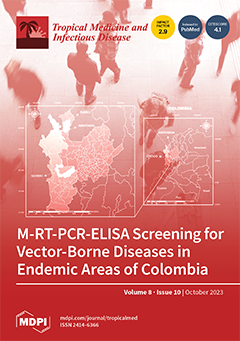Plasmodium knowlesi (
Pk) causes zoonotic malaria and is known as the “fifth human malaria parasite”.
Pk malaria is an emerging threat because infections are increasing and can be fatal. While most infections are in Southeast Asia (SEA), especially Malaysia, travelers frequently visit this region and can present with
Pk malaria around the world. So, clinicians need to know (1) patients who present with fever after recent travel to SEA might be infected with
Pk and (2)
Pk is often misdiagnosed as
P. malariae (which typically causes less severe malaria). Here we review the history, pathophysiology, clinical features, diagnosis, and treatment of
Pk malaria. Severe disease is most common in adults. Signs and symptoms can include fever, abdominal pain, jaundice, acute kidney injury, acute respiratory distress syndrome, hyponatremia, hyperparasitemia, and thrombocytopenia. Dengue is one of the diseases to be considered in the differential. Regarding pathophysiologic mechanisms, when
Pk parasites invade mature red blood cells (RBCs, i.e., normocytes) and reticulocytes, changes in the red blood cell (RBC) surface can result in life-threatening cytoadherence, sequestration, and reduced RBC deformability. Since molecular mechanisms involving the erythrocytic stage are responsible for onset of severe disease and lethal outcomes, it is biologically plausible that manual exchange transfusion (ET) or automated RBC exchange (RBCX) could be highly beneficial by replacing “sticky” parasitized RBCs with uninfected, deformable, healthy donor RBCs. Here we suggest use of special
Pk-resistant donor RBCs to optimize adjunctive manual ET/RBCX for malaria. “Therapeutically-rational exchange transfusion” (T-REX) is proposed in which
Pk-resistant RBCs are transfused (instead of disease-promoting RBCs). Because expression of the Duffy antigen on the surface of human RBCs is essential for parasite invasion, T-REX of Duffy-negative RBCs—also known as Fy(a-b-) RBCs—could replace the majority of the patient’s circulating normocytes with
Pk invasion-resistant RBCs (in a single procedure lasting about 2 h). When sequestered or non-sequestered iRBCs rupture—in a 24 h
Pk asexual life cycle—the released merozoites cannot invade Fy(a-b-) RBCs. When Fy(a-b-) RBC units are scarce (e.g., in Malaysia), clinicians can consider the risks and benefits of transfusing plausibly
Pk-resistant RBCs, such as glucose-6-phosphate dehydrogenase deficient (G6PDd) RBCs and Southeast Asian ovalocytes (SAO). Patients typically require a very short recovery time (<1 h) after the procedure. Fy(a-b-) RBCs should have a normal lifespan, while SAO and G6PDd RBCs may have mildly reduced half-lives. Because SAO and G6PDd RBCs come from screened blood donors who are healthy and not anemic, these RBCs have a low-risk for hemolysis and do not need to be removed after the patient recovers from malaria. T-REX could be especially useful if (1) antimalarial medications are not readily available, (2) patients are likely to progress to severe disease, or (3) drug-resistant strains emerge. In conclusion, T-REX is a proposed optimization of manual ET/RBCX that has not yet been utilized but can be considered by physicians to treat
Pk malaria patients.
Full article






